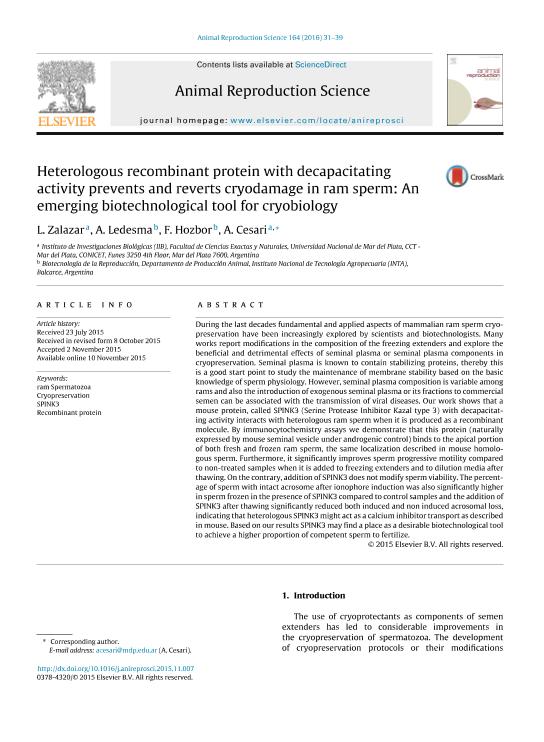Mostrar el registro sencillo del ítem
dc.contributor.author
Zalazar, Lucia

dc.contributor.author
Ledesma, Alba

dc.contributor.author
Hozbor, Federico Andrés

dc.contributor.author
Cesari, Andreina

dc.date.available
2018-10-11T20:50:27Z
dc.date.issued
2016-01
dc.identifier.citation
Zalazar, Lucia; Ledesma, Alba; Hozbor, Federico Andrés; Cesari, Andreina; Heterologous recombinant protein with decapacitating activity prevents and reverts cryodamage in ram sperm: An emerging biotechnological tool for cryobiology; Elsevier Science; Animal Reproduction Science; 164; 1-2016; 31-39
dc.identifier.issn
0378-4320
dc.identifier.uri
http://hdl.handle.net/11336/62266
dc.description.abstract
During the last decades fundamental and applied aspects of mammalian ram sperm cryopreservation have been increasingly explored by scientists and biotechnologists. Many works report modifications in the composition of the freezing extenders and explore the beneficial and detrimental effects of seminal plasma or seminal plasma components in cryopreservation. Seminal plasma is known to contain stabilizing proteins, thereby this is a good start point to study the maintenance of membrane stability based on the basic knowledge of sperm physiology. However, seminal plasma composition is variable among rams and also the introduction of exogenous seminal plasma or its fractions to commercial semen can be associated with the transmission of viral diseases. Our work shows that a mouse protein, called SPINK3 (Serine Protease Inhibitor Kazal type 3) with decapacitating activity interacts with heterologous ram sperm when it is produced as a recombinant molecule. By immunocytochemistry assays we demonstrate that this protein (naturally expressed by mouse seminal vesicle under androgenic control) binds to the apical portion of both fresh and frozen ram sperm, the same localization described in mouse homologous sperm. Furthermore, it significantly improves sperm progressive motility compared to non-treated samples when it is added to freezing extenders and to dilution media after thawing. On the contrary, addition of SPINK3 does not modify sperm viability. The percentage of sperm with intact acrosome after ionophore induction was also significantly higher in sperm frozen in the presence of SPINK3 compared to control samples and the addition of SPINK3 after thawing significantly reduced both induced and non induced acrosomal loss, indicating that heterologous SPINK3 might act as a calcium inhibitor transport as described in mouse. Based on our results SPINK3 may find a place as a desirable biotechnological tool to achieve a higher proportion of competent sperm to fertilize.
dc.format
application/pdf
dc.language.iso
eng
dc.publisher
Elsevier Science

dc.rights
info:eu-repo/semantics/openAccess
dc.rights.uri
https://creativecommons.org/licenses/by-nc-sa/2.5/ar/
dc.subject
Cryopreservation
dc.subject
Ram Spermatozoa
dc.subject
Recombinant Protein
dc.subject
Spink3
dc.subject.classification
Otras Ciencias Biológicas

dc.subject.classification
Ciencias Biológicas

dc.subject.classification
CIENCIAS NATURALES Y EXACTAS

dc.title
Heterologous recombinant protein with decapacitating activity prevents and reverts cryodamage in ram sperm: An emerging biotechnological tool for cryobiology
dc.type
info:eu-repo/semantics/article
dc.type
info:ar-repo/semantics/artículo
dc.type
info:eu-repo/semantics/publishedVersion
dc.date.updated
2018-10-09T19:57:03Z
dc.journal.volume
164
dc.journal.pagination
31-39
dc.journal.pais
Países Bajos

dc.journal.ciudad
Amsterdam
dc.description.fil
Fil: Zalazar, Lucia. Consejo Nacional de Investigaciones Científicas y Técnicas. Centro Científico Tecnológico Conicet - Mar del Plata. Instituto de Investigaciones Biológicas. Universidad Nacional de Mar del Plata. Facultad de Ciencias Exactas y Naturales. Instituto de Investigaciones Biológicas; Argentina
dc.description.fil
Fil: Ledesma, Alba. Consejo Nacional de Investigaciones Científicas y Técnicas; Argentina. Instituto Nacional de Tecnología Agropecuaria. Centro Regional Buenos Aires Sur. Estación Experimental Agropecuaria Balcarce. Laboratorio de Biotecnología de la Reproduccion; Argentina
dc.description.fil
Fil: Hozbor, Federico Andrés. Instituto Nacional de Tecnología Agropecuaria. Centro Regional Buenos Aires Sur. Estación Experimental Agropecuaria Balcarce. Laboratorio de Biotecnología de la Reproduccion; Argentina
dc.description.fil
Fil: Cesari, Andreina. Consejo Nacional de Investigaciones Científicas y Técnicas. Centro Científico Tecnológico Conicet - Mar del Plata. Instituto de Investigaciones Biológicas. Universidad Nacional de Mar del Plata. Facultad de Ciencias Exactas y Naturales. Instituto de Investigaciones Biológicas; Argentina
dc.journal.title
Animal Reproduction Science

dc.relation.alternativeid
info:eu-repo/semantics/altIdentifier/doi/https://dx.doi.org/10.1016/j.anireprosci.2015.11.007
dc.relation.alternativeid
info:eu-repo/semantics/altIdentifier/url/https://linkinghub.elsevier.com/retrieve/pii/S0378432015300506
Archivos asociados
